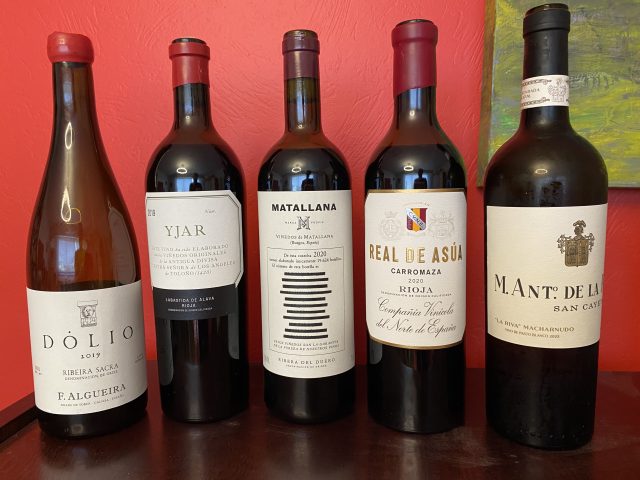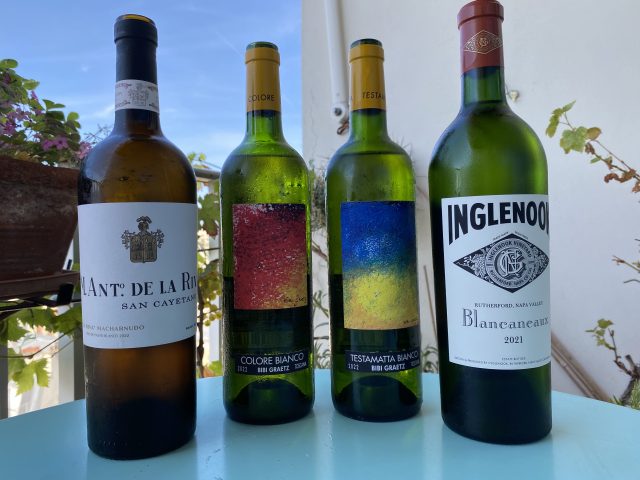This website uses cookies so that we can provide you with the best user experience possible. Cookie information is stored in your browser and performs functions such as recognising you when you return to our website and helping our team to understand which sections of the website you find most interesting and useful.
The stars of the September ‘hors Bordeaux’ releases part II – a ‘wake up’ for La Place
With the ‘beyond Bordeaux’ September campaign now well underway, db’s Bordeaux correspondent Colin Hay looks at the latest releases, finding that while it is an unquestionably glittering display, all that glitters does not necessarily turn to gold.

The ‘hors Bordeaux’ September campaign has seen a flurry of activity, with amongst others, Domaine de la Chapelle, Almaviva, Opus One, Clos Apalta, Caro, Quintessa, Seña, Chateau de Beaucastel, Masseto and Inglenook already released. This week has already seen further releases from Bibi Graetz and Vérité with plenty more to come from the likes of Morlet, Paul Hobbs, Catena Zapata and Telmo Rodriguez to name but a few. It is an unquestionably glittering display, but all that glitters does not necessarily turn to gold.
So what are the early signals from the campaign? Over the last couple of weeks I have spoken to a number of the producers themselves, as well as to the leading courtiers and négociants specialising in the hors Bordeaux market and also to a number of UK and French-based buyers in the on-trade at professional tastings in both London and Paris. To make things a little easier, I’m going to treat all of these conversations as ‘off the record’.
There is no questioning the difficulty of the market conditions. And no-one that I spoke to is in any doubt that this will have a significant bearing on the success – and, just as importantly, the perceived success – of the campaign.
We are simply not in conditions conducive to these wines selling out on La Place within hours or days of their release, as was the case for many of the equivalent releases (old and new alike) even last year. We need to recalibrate our sense of what would count as a successful campaign in the light of that. And what was perhaps most interesting to me was that, amongst at least those to whom I spoke, that had already happened. Whether courtiers, négociants, producers or, indeed, members of the on-trade, la place and its most important clients were very much of one voice.
The contrast with the Bordeaux 2022 en primeur campaign is, in that respect, stark. If there is a problem here it is with the market conditions and not with the choices being made by those bringing these wines to la place and from la place to the global market. Broadly speaking, I share that analysis. But with one or two little caveats.
What I found in tasting rooms in Bordeaux, Paris and London was a quiet confidence and a steely determination amongst almost all of those to whom I spoke –a little more of the latter in some cases and, by implication, a little more of the former in others. Not entirely surprisingly, those I knew better were just a touch more sanguine in their assessment. But no-one is throwing in the towel, even if initial sales have tended to confirm the bleaker prognoses of the market conditions preceding the campaign. Someone I spoke to suggested, slightly mischievously perhaps, that we should be thinking of this less as a September campaign and more of an autumn campaign. Indeed. Time will tell if the troops make it home for Christmas!
The first question (and often the final question too) is that of price. But, however perverse though it might seem, and with the exception of some of the always-difficult-to-price first time releases on la place, the problem of this September’s releases is not in the end significantly one of price.
With, again, a couple of (sometimes notable) exceptions, it is not at all clear to me that those wines that have thus far struggled to find their market would have fared much better had they been offered at a modest discount (rather than a modest increase) on last year’s release price. That was definitively not the case for Bordeaux 2022, not least because, amongst the 50 to 100 wines that constitute the core of the en primeur market, the relative price-rise was simply so much higher. But even had it not been, Bordeaux 2022 was never going to fly off the metaphoric shelf.
The hors Bordeaux market is a little different but not entirely so. For the economic fundamentals are, in the end, the same. Indeed, as it hardly needs me to point out to anyone, those fundamentals have worsened since en primeur.
But all of that said, there is, in the end, a global demand for these wines at the prices for which they are being offered. But it is going to take rather more effort and investment on the part of the négociants to tap that demand than they have been accustomed to up until now. The March releases were, in that respect, something of a wake-up call. And, let’s be clear here, even at the risk of repetition. The market conditions have deteriorated significantly since March. No-one is in any doubt about that.
The autumn campaign – let’s call it that for now – is becoming, or is likely to become, something of a test of the famous capillarity that La Place’s no less famous distribution model claims to provide. Capillarity can mean a variety of things. Here, very simply, it is the capacity to place a bottle of a coveted wine in the hands of a consumer anywhere in the world who might wish to purchase it. It is about servicing demand wherever it exists. Traditional single country-single importer distribution models cannot provide that. La Place can – at least in theory. The question now is whether La Place does – in practice.
And the answer is that it does so more or less well, depending on the wine and, indeed, the courtier-négociant combination (with there being a definite and growing advantage to being on la place with a courtier to coordinate the division of labour in the search for capillarity).
The bottom line, brutally stated, is that when Petrus can today be found on the secondary market for 20% less than its secondary market price a couple of months ago, new releases are not likely to prove an easy sell regardless of the quality of the wine. In such a context, gaining additional capillarity – and with it the capacity to access demand one was previously unable to service – is the very best solution. It is perhaps also the only credible short-term solution – and it is certainly better than discounting the wine until it reaches today’s clearance price. The consumer might disagree. But clearance price discounting in fact only fuels speculation. And it is never ultimately the consumer who benefits from that.
The big négociants – or, at least, those most implicated in the hors Bordeaux market – have known all of this (certainly the bit about capillarity) for a long time. They work differently from the others and they always (or almost always) use a courtier. But the model that they have developed now needs to be more widely diffused. It entails a lot more work for individual négoces, often working alongside the properties themselves, in each and every significant market for la place’s hors Bordeaux offerings. And not all of the négociants of La Place are up for that (including some still in receipt of hors Bordeaux allocations today).

When times were good all of this was relatively easy. The négociants fought to take on their hors Bordeaux allocations safe in the knowledge that, because the wines were good, they could sell them through relatively easily with just the modest additional capillarity that came from making them available to their traditional clients. Such buyers were, in effect, adding a little additional hors Bordeaux colour (a bit of Barolo, a bit of Tuscany, a bit of Napa) to the assorted pallet of Bordeaux gems that they had shipped three-times a year from the storage of one of their favoured négociants.
That was never the best way to sell these wines, as it left much of the potential gain in capillarity un-accessed. But it worked, even with La Place functioning at far less than full capacity. Today, and for as long as the market remains as it is, that is not good enough. It works no longer. And everyone knows it.
The potential buyer of a single-vineyard Barbaresco is not the same as that for a Napa Cab nor for an Argentine Malbec. Nor, crucially, is it the same for the 1st growths or the ‘super seconds’. To access the capillarity that this now outdated model leaves untapped requires more effort – precisely the kind of effort that the leading hors Bordeaux courtier-négociants teams have been starting to put in place over recent releases.
But accessing that demand takes time and it needs to be done anew for each new wine and for each new release. That, in the end, is why this is an autumn campaign rather than a September campaign and why the troops might not be home for Christmas.

The September releases are, in short, a wake-up call for La Place. But in the medium to long-term that may well be a good thing. Up until now hors Bordeaux has arguably been too easy for the négociants who have not had to search very hard for additional capillarity in specific markets to sell through their allocations. They now recognise that they need to do so. Indeed, many are already doing so, often working far more closely with the properties themselves in the process. That might just provide the basis for some longer term confidence.
Let me finish on this positive note. There are already some promising signs. Even in the last few days there has been a slight pick-up in demand and there is a sense of a campaign that is slowly gathering momentum. Testamatta, the first wine of the campaign to be offered at a significant discount on last year’s release price will be an interesting test of my surmise. And it’ll be interesting to see if it sets a trend (Bibi Graetz, after all, is good at that)!
The spotlight is on La Place de Bordeaux, but for once not on the wines of Bordeaux. We have also seen a significant institutionalisation of the September campaign in London with now daily offers of new releases to their clients from all but a handful of the leading brokers and merchants. Finally, there has been significant trade attendance and interest, despite prevailing market conditions, at professional tastings in Bordeaux, London, Paris, Hong Kong, Tokyo and Singapore. All that glitters may not turn to gold, but La Place still retains a certain alchemy.
Click here to read Colin’s scores and detailed tasting notes by country: Italy; Spain, France, Austria and Germany; the US; Chile and Argentina; New Zealand, Australia and South Africa). In the third part of his beyond Bordeaux series, which will be released at the end of the month, Colin will identify the highlights of the campaign at different price points.
Read more
The star releases of hors Bordeaux 2023: part 1 – The Drinks Business

